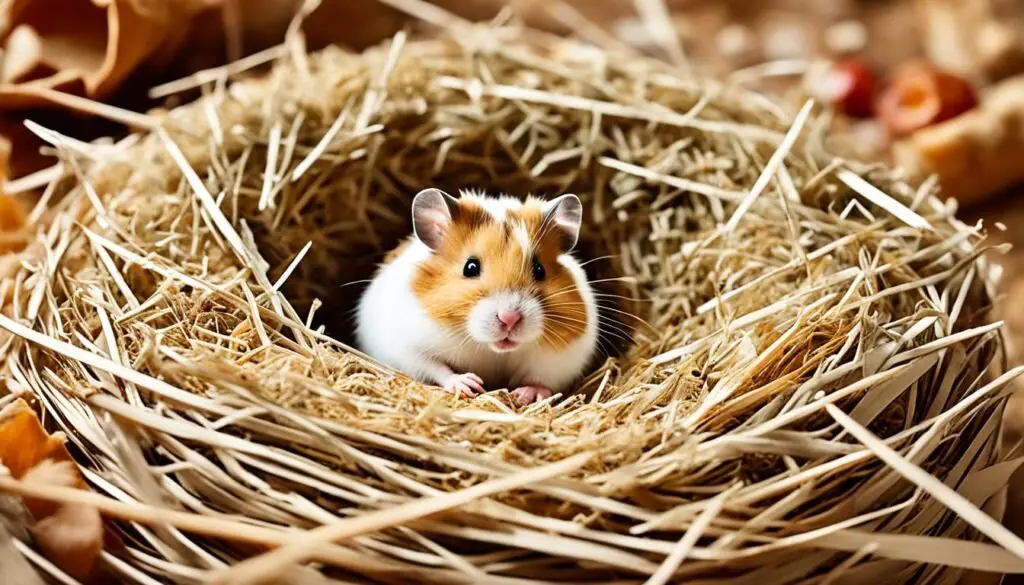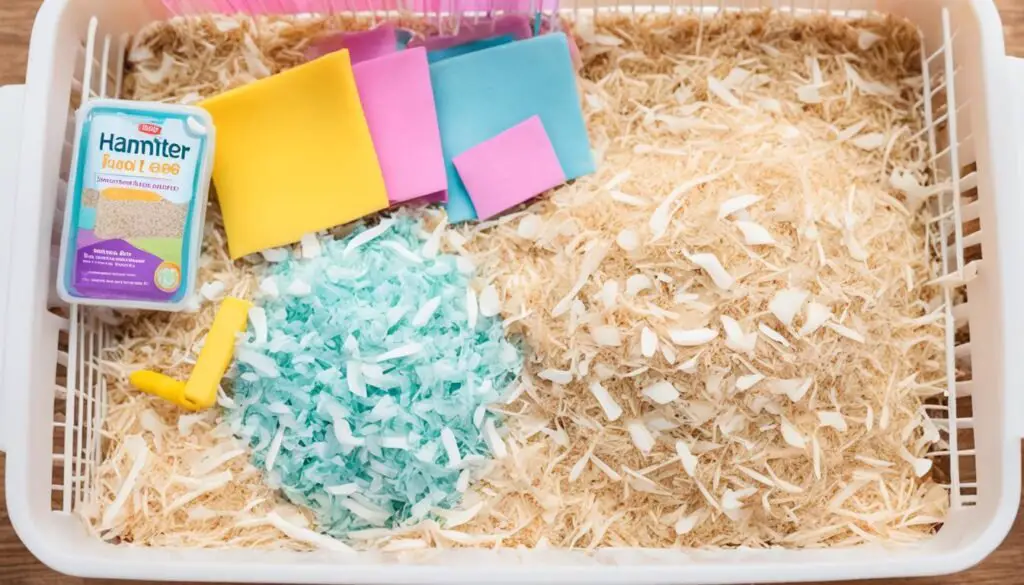Did you know that the quality of your hamster’s bedding can significantly impact their well-being and happiness? Research has shown that providing deep and comfortable bedding for your hamster enhances their welfare, allowing them to engage in natural behaviors and feel safe and secure. If you’re looking for ways to make your furry friend’s environment cozier and more enjoyable, this homemade hamster bedding guide is just what you need!
Whether you want to learn how to make homemade hamster bedding or explore safe bedding options, this article has got you covered. We’ll discuss different types of safe bedding materials, the benefits of deep bedding, DIY ideas for affordable alternatives, and essential tips for creating the perfect bedding environment for your hamster.
Let’s dive in and create a cozy paradise for your furry friend!
Types of Safe Bedding for Hamsters
When it comes to choosing bedding for your hamster, it’s important to prioritize their safety and well-being. There are several types of natural hamster bedding options that are not only eco-friendly but also provide a comfortable and cozy environment for your furry friend. Here are some of the best materials for hamster bedding:
- Paper-based bedding: Paper-based bedding, such as Carefresh and Kaytee, is a popular choice among hamster owners. It has a soft tissue clump texture that is perfect for burrowing and nesting. This type of bedding is safe, absorbent, and provides ample comfort for your hamster.
- Aspen bedding: Aspen bedding is another safe option for hamsters. It is made from aspen wood shavings and does not produce harmful dust. This type of bedding is ideal for hamsters with respiratory sensitivities, as it helps keep the air clean and fresh.
- Hemp bedding: If you’re looking for an eco-friendly hamster bedding option, hemp bedding is a great choice. It is made from natural hemp fibers, which are safe for your hamster to burrow and nest in. Hemp bedding is also highly absorbent and controls odors effectively.
- Soft hay and soil: To create a more natural environment for your hamster, you can add soft hay and soil to their bedding. These materials provide additional nesting material and allow your hamster to engage in natural behaviors.

It’s important to note that there are certain materials you should avoid when it comes to hamster bedding. These include sawdust, pine, cedar, scented bedding, and corn cob bedding, as they can pose health risks to your hamster.
Benefits of Deep Bedding for Hamsters
Research has shown that providing hamsters with deep bedding enhances their welfare. Hamsters are natural burrowers and enjoy digging and creating tunnels. Deep bedding allows them to engage in natural behaviors and reduces stress. It also provides insulation and protection from hot or cold temperatures. The RSPCA recommends a minimum of 6 inches of bedding, but a depth of 10 inches or more is ideal. Deep bedding allows hamsters to create deeper burrows, which mimics their natural habitat and helps them feel safe and secure.
Deep bedding not only enhances your hamster’s well-being but also provides various benefits:
- Comfort: Thick bedding offers a soft and cozy substrate for your hamster to rest and sleep on.
- Exploration and Enrichment: The deep bedding provides your hamster with opportunities for exploration and enrichment, allowing them to dig, tunnel, and hide, which are vital natural behaviors.
- Thermal Regulation: The thick bedding layer acts as insulation, helping to maintain a comfortable temperature for your hamster’s enclosure and protecting them from extreme heat or cold.
- Noise Reduction: Deep bedding helps absorb sound, creating a quieter environment for your hamster.
- Odor Control: Adequate amounts of bedding can help absorb and reduce odors, keeping your hamster’s cage smelling fresh.
Overall, deep bedding provides a more natural and stimulating environment for your hamster, promoting their physical and mental well-being. Now that you understand the benefits, let’s explore some simple and affordable homemade bedding ideas in the next section.
Safe DIY Hamster Bedding Ideas
If you’re looking for affordable and safe bedding options for your hamster, consider these easy DIY ideas. Not only are they budget-friendly, but they also provide your furry friend with a cozy and comfortable place to nest. Here are some homemade hamster bedding ideas that you can try:
- Shredded White Paper: Shredded white paper is a fantastic choice for hamster bedding. It’s safe, affordable, and can be easily made at home using a shredder machine. Simply shred some white paper into small, soft pieces and use it to line your hamster’s nest. This DIY option is readily available and provides a cozy material for your hamster to burrow and snuggle in.
- Toilet Paper: Toilet paper can be a handy alternative for hamster bedding. Take a few unscented rolls of toilet paper and tear them into strips or small squares. Your hamster will enjoy using these soft paper pieces for nesting and creating their cozy hideout.
- Tissue Paper: Tissue paper is another excellent option for DIY hamster bedding. Like toilet paper, it’s soft and safe for your pet. Tear the tissue paper into small, manageable pieces and provide it as bedding material. Make sure to use unscented tissue paper to avoid any potential harm to your hamster.
- Combination of DIY Bedding: If you have a mix of shredded white paper, toilet paper, and tissue paper, you can combine them to offer a variety of textures and comforts for your hamster. This combination will allow your hamster to choose their preferred nesting material and create a cozy space to relax in.
These DIY hamster bedding ideas are not only affordable but also safe and comfortable for your furry friend. Experiment with different combinations and textures to find the perfect bedding material that suits your hamster’s preferences.

Additional Tips:
- Make sure the DIY bedding materials are clean and free of any contaminants.
- Replace the bedding regularly to maintain cleanliness and hygiene in the cage.
- Monitor your hamster’s behavior and ensure they are comfortable with the chosen bedding option.
- Avoid using materials that could potentially harm your hamster, such as scented papers or toxic substances.
- Keep an eye on your hamster’s overall health and well-being to ensure that the bedding is not causing any issues.
With these DIY hamster bedding ideas, you can provide your hamster with a safe and cozy nesting environment without breaking the bank. Get creative and enjoy the process of creating a comfortable space for your furry friend!
Bedding Tips and Considerations
When it comes to using bedding for your hamster, there are a few tips and considerations to keep in mind. Firstly, if your bedding is dusty, you can easily remove the excess dust by sifting or shaking it. This helps create a cleaner and healthier environment for your furry friend.
Another important tip is to freeze the bedding before use. Freezing it can help kill any potential harmful bugs that might be present, ensuring the safety of your hamster. It’s a simple yet effective way to minimize the risk of unwanted pests.
Creating a dedicated digging zone in your hamster’s cage is also essential. Hamsters are natural burrowers, so providing them with a designated area to dig allows them to engage in their natural behaviors. This not only keeps them entertained but also promotes their overall mental and physical well-being.
In addition to the bedding, you can consider adding soft hay to your hamster’s cage. It serves as extra nesting material and provides additional comfort for your pet. However, make sure the hay is soft to avoid any potential injuries.
An easy trick to make spot cleaning a breeze is to choose white bedding. It makes it easier to identify and remove any soiled areas, ensuring a cleaner living environment for your hamster.
Lastly, adding decorative elements like colorful party napkins can bring a touch of fun to your hamster’s cage. It’s a creative way to personalize their living space and make it visually appealing.
